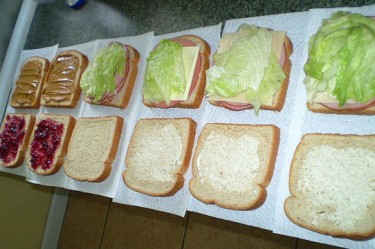
In last week's episode of The Sporkful, I spoke with Ian Chillag and Mike Danforth, the multi-talented NPR guys who host the podcast How To Do Everything, produce Wait Wait...Don't Tell Me, and run The Salt blog's Sandwich Monday feature.
But the conversation wasn't without controversy, especially when we covered the issue of the correct definition of a sandwich. (Listen above to that part of the episode.)
When I asked Ian about Sandwich Monday's ever-expanding definition of this beloved form, he cited "The Neuhaus Rule," which defines a sandwich as "any protein encased in carbs," and further argued for Sandwich's Monday's right to "draft" any food into the sandwich oeuvre if it doesn't already fit into a known food category.
As I told Ian, I find this reasoning to be both faulty and dangerous. I am a strict constructionist, which means I believe we must look at the framer's original intent to determine the definition of a sandwich. (That's why I'm known as The Scalia of Sandwiches.)
So what was the Earl of Sandwich's intent? The noted scholarly resource Wikipedia offers a history lesson:
A rumour in a contemporary travel book called Tour to London by Pierre Jean Grosley formed the popular myth that bread and meat sustained Lord Sandwich at the gambling table. A very conversant gambler, Lord Sandwich did not take the time to have a meal during his long hours playing at the card table. Consequently, he would ask his servants to bring him slices of meat between two slices of bread . . . The sober alternative is provided by Sandwich's biographer, N. A. M. Rodger, who suggests Sandwich's commitments to the navy, to politics and the arts mean the first sandwich was more likely to have been consumed at his work desk.
Thus, for a food to be considered a sandwich, I argue it must meet two criteria:
1) The Eater must be able to pick it up and eat it, with minimal mess to the hands.
2) The fillings must be sandwiched between two discrete food items.
By this logic a breadless sandwich is valid, but neither open-faced sandwiches nor burritos belong in the category.
Ian tried to use tape rewind technology to argue that the simple fact that I used the term "open-faced sandwich" was an implicit acknowledgement of its place in the sandwich canon. Mike suggested that the Earl of Sandwich could not have anticipated the burrito. I think that in both cases, I beat back their rhetorical deceptions.
What's your take on this debate? What is the correct definition of a sandwich?
And should inquiries be made with NPR's ombudsman, who monitors the use and misuse of language at NPR, among other issues? (I think so. Contact him here.)
Listen to the sandwich conversation above, and check out last week's episode of The Sporkful for more of my conversation with Ian Chillag and Mike Danforth.
Photo: Flickr CC / EvelynGiggles


